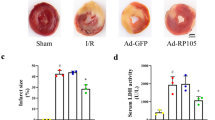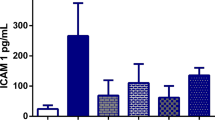Abstract
This study was designed to evaluate the anti-inflammatory and anti-apoptotic effects of the alcoholic extract of the berries of Crataegus oxyacantha (AEC), a medicinal herb, on isoproterenol-induced myocardial infarction (MI) in a rat model. Three groups of Wistar albino rats, each comprising six animals, were selected for this study. Group I rats served as control. Group II rats were given isoproterenol (85 mg/kg body weight) subcutaneously on 59th and 60th days. Group III rats were given AEC (0.5 ml/100 g body weight/day), orally on a daily basis for 60 days, and isoproterenol (85 mg/kg body weight, subcutaneously) was given on 59th and 60th days. On the 61st day, the animals were sacrificed, and marker enzymes like lactate dehydrogenase (LDH) and creatine kinase (CK) were estimated in serum. In the heart tissue sample, antioxidant status, lipid peroxidation and anti-inflammatory properties of AEC were determined. Isoproterenol significantly increased the release of LDH, CK in serum, decreased the antioxidant status in the heart along with an increase in lipid peroxidation. Nitritive stress and apoptosis were seen in isoproterenol-induced rat heart. Pre-treatment with the AEC for 60 days had a significant effect on all the above factors and maintained near normal status. The study confirms the protective effect of AEC against isoproterenol-induced inflammation and apoptosis-associated MI in rats.









Similar content being viewed by others
References
Taimor G, Hofstaetter B, Piper HM (2000) Apoptosis induction by nitric oxide in adult cardiomyocytes via cGMP-signaling and its impairment after simulated ischemia. Cardiovasc Res 45(3):588–594
World Health Organisation (2006) Annex 2: death by cause, sex and mortality stratum in WHO regions, estimates for 2002. World Health Organisation, Geneva
Levy RI, Feinleib M (1984) Risk factors for coronary artery disease and their management. In: Brawnwald E (ed) Heart disease. A textbook of cardiovascular medicine Vol 2, 2nd edn. WB Saunders, Philadelphia, pp 1205–1234
Rajadurai M, Prince PS (2005) Comparative effects of Aegle marmelos extract and alpha-tocopherol on serum lipids, lipid peroxides and cardiac enzyme levels in rats with isoproterenol-induced myocardial infarction. Singapore Med J 46:78–81
Song YH, Cai H, Gu N, Qian CF, Cao SP, Zhao ZM (2011) Icariin attenuates cardiac remodelling through down-regulating myocardial apoptosis and matrix metalloproteinase activity in rats with congestive heart failure. J Pharm Pharmacol 63(4):541–549
Sasikumar CS, Devi CS (2000) Effect of abana an ayurvedic formulation, on lipid peroxidation in experimental myocardial infarction in rats. Indian J Exp Biol 38(8):827–830
Shanthi S, Parasakthy K, Deepalakshmi PD, Devaraj SN (1994) Hypolipdemic activity of tincture of Crataegus in rats. Indian J Biochem Biophys 31:143–146
Karthikeyan K, Bai BR, Devaraj SN (2007) Efficacy of grape seed proanthocyanidins on serum and heart tissue lipids in rats subjected to isoproterenol-induced myocardial injury. Vascul Pharmacol 47(5–6):295–301
King J (1965) The dehydrogenases or oxidoreductases, Lactate dehydrogenase in practical clinical enzymology. Van D Nostrand, London 83–93
Okinaka S, Kumagai H, Ebashi S, Sugita H, Momoi H, Toyokura Y, Fujie Y (1961) Serum creatine phosphokinase. Activity in progressive muscular dystrophy and neuromuscular diseases. Arch Neurol 4:520–525
Lowry OH, Rosebrough NJ, Farr AL, Randall RJ (1951) Protein measurement with the folin phenol reagent. J Biol Chem 193:265
Weydert CJ, Cullen JJ (2010) Measuremnet of superoxide dismutase, catalase and glutathione peroxidise in cultured cells and tissue. Nat Protoc 5(1):51–66 (Epub 2009 Dec 17)
Higuchi Y, Linn S (1995) Purification of all forms of HeLa cell mitochondrial DNA and assessment of damage to it caused by hydrogen peroxide treatment of mitochondria or cells. J Biol Chem 270(14):7950–7956
Buege JA, Aust SD (1978) Microsomal lipid peroxidation. Methods Enzymol 52:302–315
Pearl W, Cascarano J, Zweifach BW (1963) Microdetermination of cytochrome oxidase in rat tissues by the oxidation of N-phenyl-p-phenylenediamine or ascorbic acid. J Histochem Cytochem 11:102. doi:10.1177/11.1.102
Moshage H, Kok B, Huizenga JR, Jansen PL (1995) Nitrite and nitrate determination in plasma: a critical evaluation. Clin Chem 41:892–896
Gill C, Mestril R, Samali A (2002) Losing heart: the role of apoptosis in heart disease—a novel therapeutic target? FASEB J 16(2):135–146
Rigelsky JM, Sweet BV (2002) Hawthorn: pharmacology and therapeutic uses. Am J Health Syst Pharm 59(5):417–422
Rembold CM, Chen XL (1998) The buffer barrier hypothesis, [Ca2+]i homogeneity, and sarcoplasmic reticulum function in swine carotid artery. J Physiol 513(Pt 2):477–492
Brawley L, Shaw AM, MacDonald A (2000) Role of endothelium/nitric oxide in a typical beta-adrenoceptor-mediated relaxation in rat isolated aorta. Eur J Pharmacol 398(2):285–296
Ferro A, Queen LR, Priest RM, Xu B, Ritter JM, Poston L, Ward JP (1999) Activation of nitric oxide synthase by beta 2-adrenoceptors in human umbilical vein endothelium in vitro. Br J Pharmacol 126(8):1872–1880
Davel AP, Kawamoto EM, Scavone C, Vassallo DV, Rossoni LV (2006) Changes in vascular reactivity following administration of isoproterenol for 1 week: a role for endothelial modulation. Br J Pharmacol 148(5):629–639
Jayalakshmi R, Niranjali Devaraj S (2004) Cardioprotective effect of tincture of Crataegus on isoproterenol-induced myocardial infarction in rats. J Pharm Pharmacol 56:921–926
Snyder CM, Shroff EH, Liu J, Chandel NS (2009) Nitric oxide induces cell death by regulating anti-apoptotic BCL-2 family members. PLoS One 4(9):e7059
Kim SF, Huri DA, Snyder SH (2005) Inducible nitric oxide synthase binds, S-nitrosylates, and activates cyclooxygenase-2. Science. doi:10.1126/science.1119407
Hajjar DP, Lander HM, Pearce FS, Upmacis RK, Pomerantz KB (1995) Nitric oxide enhances prostaglandin-H synthase activity by a heme-independent mechanism: evidence implicating nitrosothiols. J Am Chem Soc 117:3340–3346
Saito T, Rodger IW, Shennib H, Hu F, Tayara L, Giaid A (2003) Cyclooxygenase-2 (COX-2) in acute myocardial infarction: cellular expression and use of selective COX-2 inhibitor. Can J Physiol Pharmacol 81(2):114–119
Zhang Z, Vezza R, Plappert T, McNamara P, Lawson JA, Austin S, Praticò D, Sutton MS, Fitz Gerald GA (2003) COX-2-dependent cardiac failure in Gh/tTG transgenic mice. Circ Res 92(10):1153–1161
Banerjee SK, Sood S, Dinda AK, Das TK, Maulik SK (2003) Chronic oral administration of raw garlic protects against isoproterenol-induced myocardial necrosis in rat. Comp Biochem Physiol C Toxicol Pharmacol 136(4):377–386
Badjatia N, Satyam A, Singh P, Seth A, Sharma A (2009) Altered antioxidant status and lipid peroxidation in Indian patients with urothelial bladder carcinoma. J Urol Oncol 28:1–8
Beckman JS, Koppenol WH (1996) Nitric oxide, superoxide, and peroxynitrite: the good, the bad, and ugly. Am J Physiol 271:C1424–C1437
Virag L, Marmer DJ, Szabo C (1998) Crucial role of apopain in the peroxynirite-induced apoptotic DNA fragmentation. Free Radic boil Med 25:1075–1082
Ushmorov A, Ratter F, Lehmann V (1999) Nitric-oxide-induced apoptosis in human leukemic lines requires mitochondrial lipid degradation and cytochrome c release. Blood 93:2342–2352
MacMillan-Crow LA, Crow JP, Thompson JA (1998) Peroxynitrite-mediated inactivation of manganese superoxide dismutase involves nitration and oxidation of critical tyrosine residue. Biochemistry 37:1613–1622
Oyadomari S, Takeda K, Takiguchi M (2001) Nitric oxide-induced apoptosis in pancreatic beta cells is mediated by the endoplasmic reticulum stress pathway. Proc Natl Acad Sci USA 98:10845–10850
Jayachandran KS, Khan M, Selvendiran K, Devaraj SN, Kuppusamy P (2010) Crataegus oxyacantha extract attenuates apoptotic incidence in myocardial Ischemia–reperfusion injury by regulating AKT and HiF-1 signalling pathways. J. Cardiovascu pharmocol 56(5):526–531
Hoffman DL (2006) Hawthorn (online 2006 October 9). Available from: URL: http://www.crystalgard-enherbs.com/HerbRefH.htm. Accessed October 9, 2006
Thiruchenduran M, Vijayan NA, Sawaminathan JK, Devaraj SN (2010) Protective effect of grape seed proanthocyanidins against cholesterol cholic acid diet-induced hypercholesterolemia in rats. Cardiovasc Pathol 20(6):361–368
Hamalainen M, Nieminen R, Vuorela P, Heinonen M, Moilanen E (2007) Anti-inflammatory effects of flavonoids: genistein, kaempferol, quercetin, and daidzein inhibit STAT-1 and NF-kappa B activations, whereas flavone, isorhamnetin, naringenin, and pelargonidin inhibit only NF-kappa B activation along with their inhibitory effect on iNOS expression and NO production in activated macrophages. Mediators Inflamm 2007:45673
Author information
Authors and Affiliations
Corresponding author
Rights and permissions
About this article
Cite this article
Vijayan, N.A., Thiruchenduran, M. & Devaraj, S.N. Anti-inflammatory and anti-apoptotic effects of Crataegus oxyacantha on isoproterenol-induced myocardial damage. Mol Cell Biochem 367, 1–8 (2012). https://doi.org/10.1007/s11010-012-1251-9
Received:
Accepted:
Published:
Issue Date:
DOI: https://doi.org/10.1007/s11010-012-1251-9




